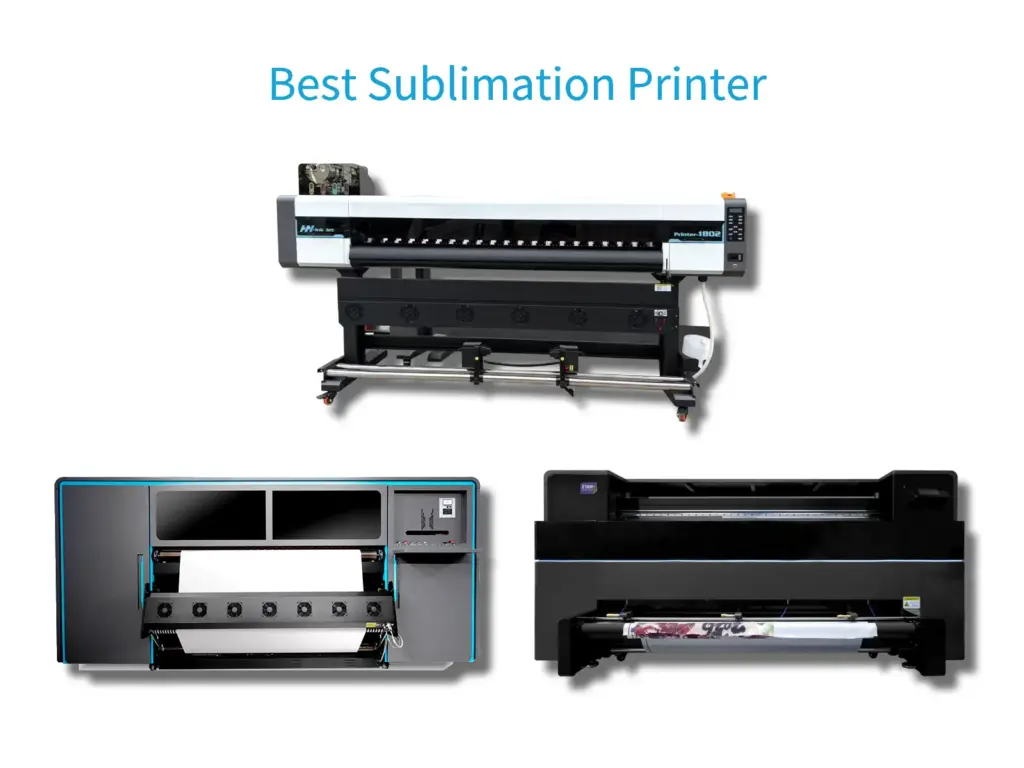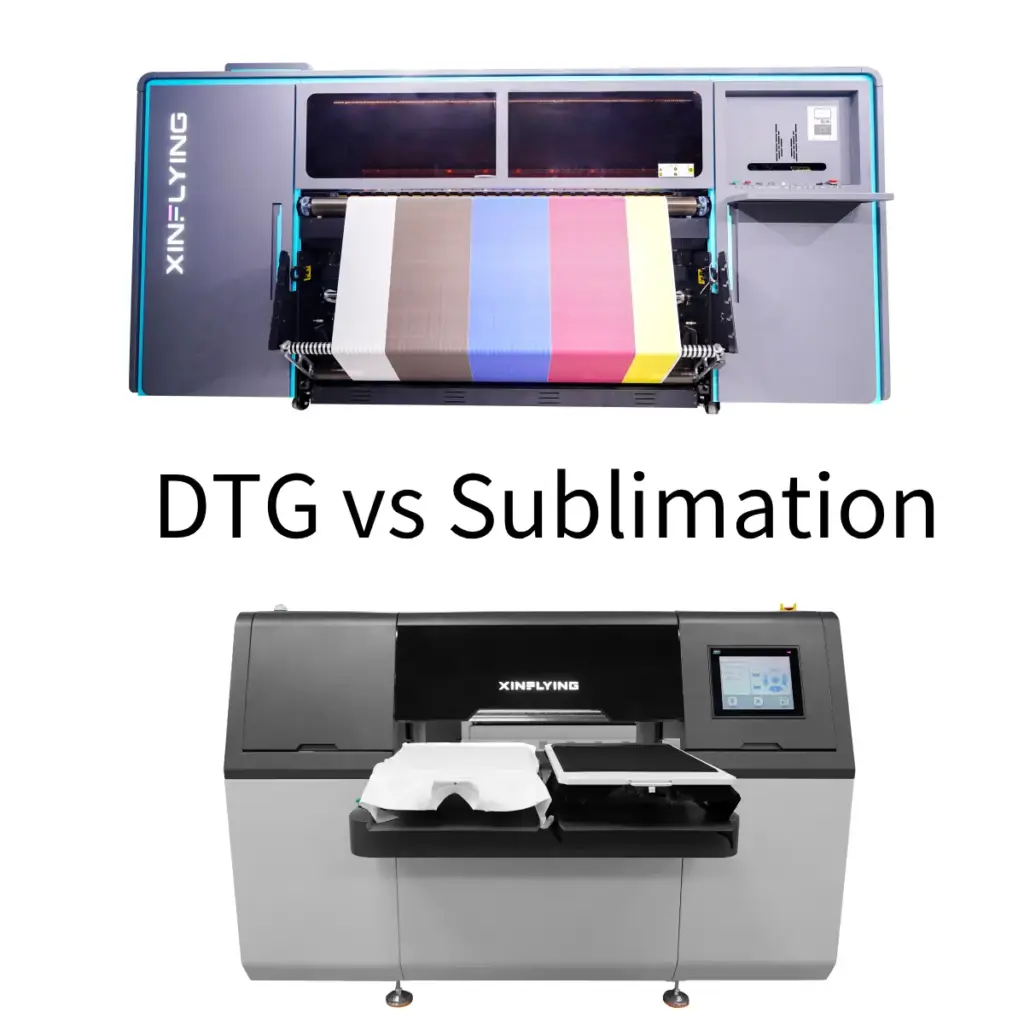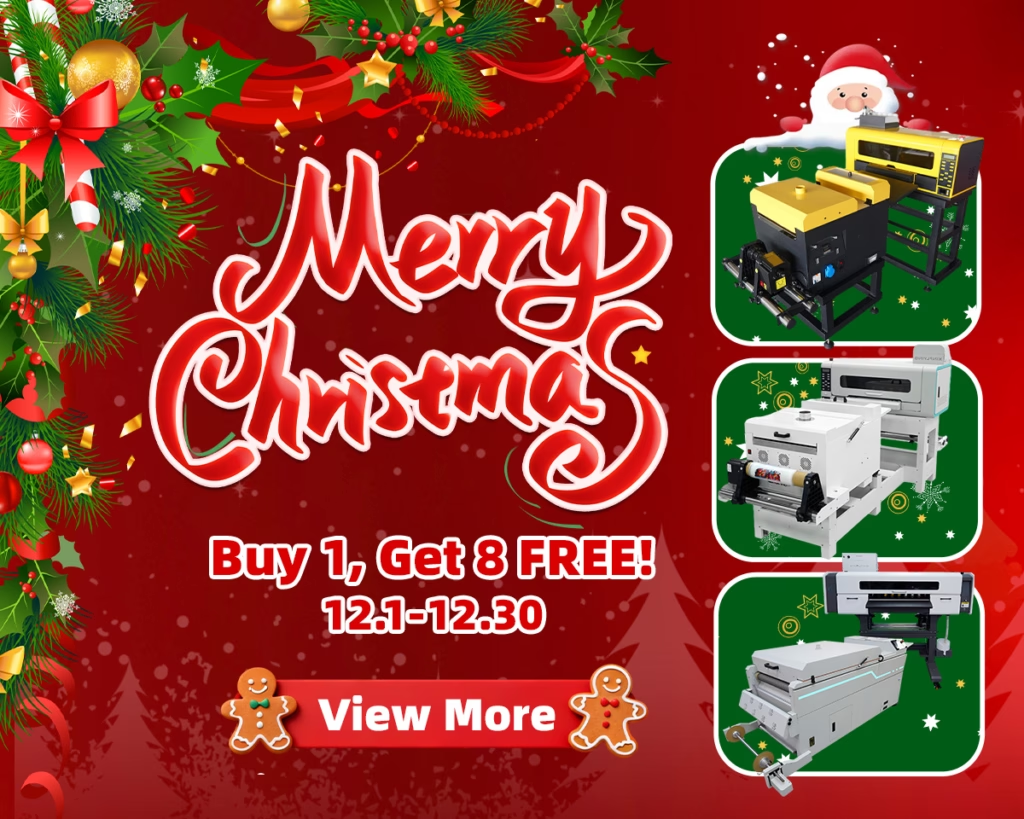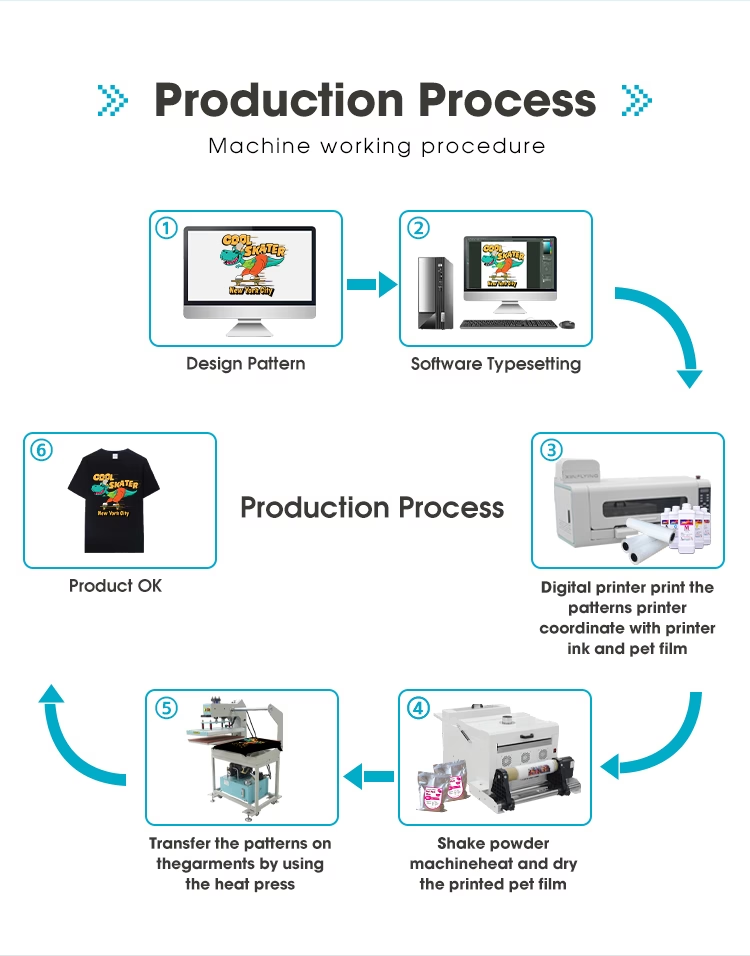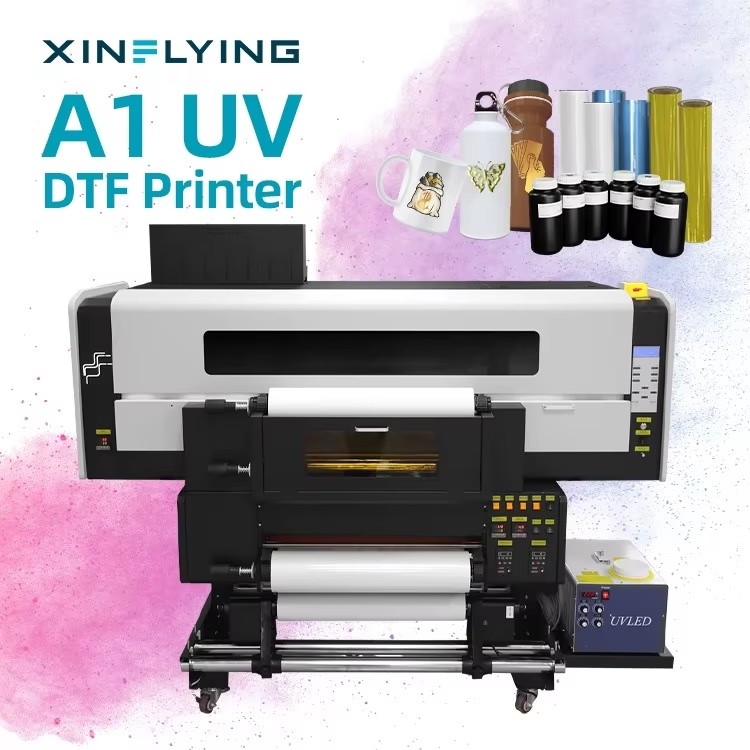A nyomtatási technológia hosszú utat tett meg, Különböző módszerek felkínálása a képek életre keltésére különböző felületeken. Két népszerű nyomtatási technika az iparban manapság az UV DTF nyomtatás és a DTF nyomtatás. Míg mindkét módszer lenyűgöző eredményeket kínál, Különböző tulajdonságaik vannak, amelyek elválasztják őket. Ebben a cikkben, Az egyes nyomtatási módszerek részleteibe belemerülünk, Hasonlítsa össze erősségeiket és korlátaikat, és adjon útmutatást az Ön igényeinek megfelelő nyomtatási módszer kiválasztásához.
Mi az UV DTF nyomtatás?
UV DTF nyomtatás, rövid az ultraibolya közvetlen filmnyomtatáshoz, egy élvonalbeli technológia, amely lehetővé teszi a magas színvonalú képátvitelt különféle szubsztrátokra. A hagyományos nyomtatási módszerekkel ellentétben, UV DTF nyomtatás ultraibolya anyagot alkalmaz (UV) A kivételes tartósság és az élénk színek érdekében ultraibolya lámpával gyógyított tinták.
Hogyan kell használni az UV DTF nyomtatót?
Lépés 1: Tervezés a RIP szoftveren
Először, Készítse elő a műalkotást a számítógépen lévő RIP szoftverrel. Ezután tegye az UV DTF -et egy filmet az UV DTF nyomtató platformjára.
Lépés 2: Nyomtatás filmre
Töltse fel előre a patront CMYK tintával, fehér tinta, és lakk, hogy kinyomtassa a formatervezést az UV dtf filmre.
Lépés 3: Laminált B -film
Helyezze a nyomtatott filmet a lamináló gépbe, hogy ragaszkodjon a B -filmhez.
Lépés 4: Helyezzen filmet a termékekre
Húzza le a minta A filmjét, és ragaszkodjon a nyomtatni kívánt elemre. Ezután lassan lehúzza le a B -filmet, és kész a terméke.
Az UV DTF nyomtatás előnyei és hátrányai

Az UV DTF nyomtatás előnyei
- Magas képminőség és élesség
Az UV DTF nyomtatás kivételes képminőséget kínál, éles részletekkel és élénk színekkel. Az UV tintáknak széles színű skálája van, A pontos szín reprodukciójának lehetővé tétele.
- Széles színű skála
Az UV DTF nyomtatás lehetővé teszi a színek széles skálájának nyomtatását a különféle szubsztrátokra, gazdag és élénk mintákat eredményez.
- Gyors termelési idő
Összehasonlítva a hagyományos nyomtatási módszerekkel, Az UV DTF nyomtatás gyorsabb termelési időket kínál. Az UV tinták szinte azonnal megszáradnak, A hosszabb szárítási periódusok szükségességének kiküszöbölése.
- Képesség különféle szubsztrátokra nyomtatni
Az UV DTF nyomtatás rugalmasságot biztosít a sokféle anyagra nyomtatáshoz, beleértve a szöveteket is, műanyagok, üveg, és több. Ez a sokoldalúság ideális választást jelent azoknak a vállalkozásoknak, amelyek diverzifikálják termékkínálatukat.
Az UV DTF nyomtatás korlátozásai
- UV tinták és berendezések költsége
Az UV DTF nyomtatáshoz speciális UV tinták és berendezések szükségesek, ami drágább lehet a hagyományos nyomtatási anyagokhoz képest. Továbbá, Az UV tintáknak rövidebb eltarthatósági ideje lehet, Gyakori csere igénylése.
- Korlátozott rugalmasság bizonyos anyagokkal
Míg az UV DTF nyomtatás alkalmazható különféle szubsztrátokra, egyes anyagok nem lehetnek megfelelőek textúrájuk vagy felületi összetételük miatt. Fontos, hogy a nagyszabású termelés elkötelezettsége előtt különféle anyagokra teszteljük a nyomtatást.
- Karbantartási és karbantartási követelmények
Az UV DTF nyomtató berendezések rendszeres karbantartást és karbantartást igényelnek a következetes teljesítmény biztosítása érdekében. Ez magában foglalja a nyomtatófejek tisztítását és az UV -kikeményedés optimális feltételeinek biztosítását.
Mi az a DTF nyomtatás?
DTF nyomtatás, vagy Közvetlenül a filmnyomtatáshoz, egy olyan technika, amely magában foglalja a tervek nyomtatását egy speciális tinták felhasználásával egy filmre, amelyeket később a kívánt szubsztrátra továbbítanak.
Hogyan kell használni a DTF nyomtatót?
Lépés 1: Tervezés a RIP szoftveren
Hasonló az UV DTF nyomtatáshoz, Tervezze meg a műalkotást grafikai tervező szoftver segítségével, A kívánt formatervezés és a képminőség elérésének biztosítása.
Lépés 2: Nyomtatás a kedvtelésből tartott filmre
Helyezze be a kedvtelésből tartott fóliát a DTF nyomtató tálcák és kezdje el a nyomtatást. Ezután a tervezési minta átkerül rá.
Lépés 3: Kötözni a tintát porral
Porrázó géppel, a DTF ragasztó por egyenletesen terjedhet a kedvtelésből tartott állatok filmjén, és kiszáradhat a grafikán.
Lépés 4: Transzfer minta textilre
Helyezze a DTF PET -fóliát a szubsztrát tetejére, és helyezze át a kialakítást a Heat Press Machine segítségével.
A DTF nyomtatás előnyei és hátrányai
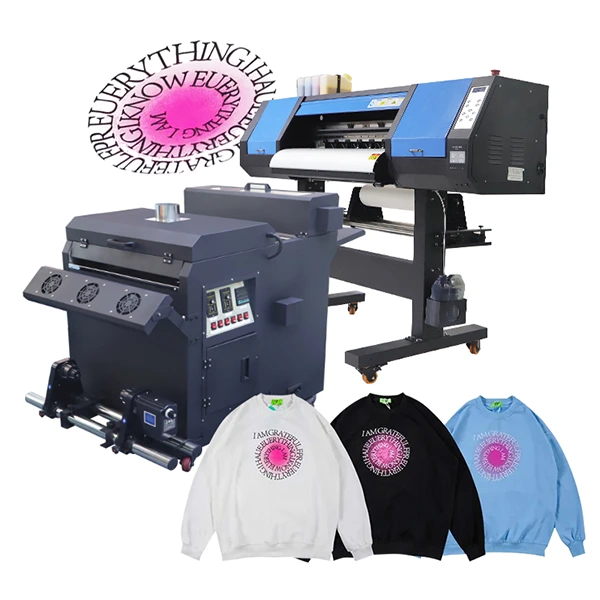
A DTF nyomtatás előnyei
- Költséghatékony nyomtatási módszer
A DTF nyomtatást költséghatékonynak tekintik, Elsősorban az alacsonyabb felszerelés és a tinta költségei miatt az UV DTF nyomtatáshoz képest. Ez hozzáférhetővé teszi a kisvállalkozások és az egyének számára, akik a nyomtatási iparba vállalkoznak.
- Sokoldalúság a kompatibilis szubsztrátok szempontjából
Mint az UV DTF nyomtatás, A DTF nyomtatás lehetővé teszi a különféle szubsztrátokra történő nyomtatást, beleértve a szöveteket is, kerámia, műanyagok, és több. Ez a sokoldalúság kibővíti a DTF nyomtatás segítségével előállított termékek körét.
- Képesség élénk színek és finom részletek elérésére
A DTF nyomtatás élénk és élénk színeket érhet el, valamint a finom részletek, a bonyolult mintákhoz és az összetett műalkotásokhoz alkalmassá teszi.
- Könnyen használható és tiszta
A DTF nyomtatók felhasználóbarátak, minimális beállítást és karbantartást igényel. Továbbá, A tisztítási folyamat viszonylag egyszerű, lehetővé téve a simább működést és a csökkentett leállási időt.
A DTF nyomtatás korlátozásai
- Korlátozott színű skála az UV DTF -hez képest
Míg a DTF nyomtatás élénk színeket érhet el, Színes skálája keskenyebb lehet az UV DTF -hez képest, A reprodukálható árnyalatok és hangok tartományának korlátozása.
- Hosszabb termelési idő
A DTF nyomtatás további lépéseket igényelhet a terv szubsztrátra történő átviteléhez, ami hosszabb termelési időt eredményezhet az UV DTF nyomtatáshoz képest.
- További lépéseket igényelhet bizonyos szövetekhez
Bizonyos szövetek nyomtatása előtt előfordulhat, hogy előkezelési folyamatokat igényel DTF tinták. Ez komplexitást és időt adhat az általános nyomtatási folyamathoz.
UV DTF VS DTF: Összehasonlítás
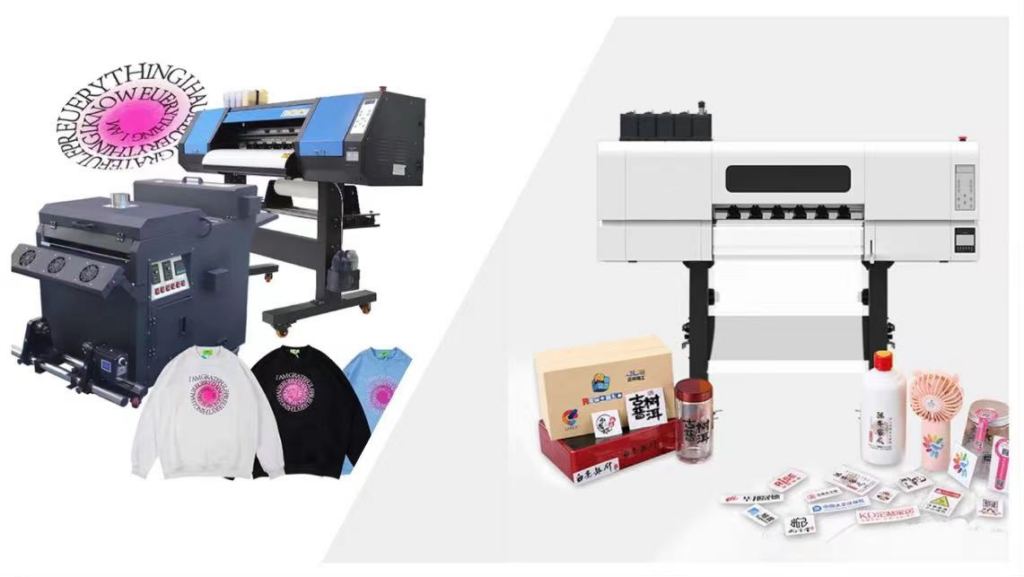
A. Nyomtatási minőség -összehasonlítás
Felbontás és élesség
Mind az UV DTF, mind a DTF nyomtatása nagy felbontású nyomatokat érhet el éles részletekkel. azonban, Az UV DTF nyomtatás kissé élesebb eredményeket kínálhat az UV -kikeményedési folyamat miatt, ami javítja a tinta tartósságát.
Színes pontosság és élénkség
Az UV DTF nyomtatás általában szélesebb színű skálát kínál, A pontosabb szín reprodukció és az élénk kialakítás lehetővé tétele. DTF nyomtatás, Míg képes élénk színekre, lehet, hogy korlátozások vannak bizonyos árnyalatok és hangok elérésében.
B. Szubsztrátok típusai
Szövet opciók
Mind az UV DTF, mind a DTF nyomtatás felhasználható különféle szövetekre történő nyomtatáshoz, beleértve a pamutot is, poliészter, és keverékek. azonban, A DTF nyomtatáshoz további lépéseket vagy előkezelést igényelhet bizonyos szövetekhez az optimális tinta tapadásának biztosítása érdekében.
Nyomtatás kemény felületekre
A kemény felületekre, például az üvegre történő nyomtatás során, műanyag, vagy kerámia, Az UV DTF nyomtatás az előnyben részesített választás. Az UV -kikeményedési folyamat biztosítja a kiváló tinta betartását és tartósságát ezeken a felületeken.
C. Termelési sebesség és hatékonyság
Az UV DTF nyomtatás gyorsabb termelési időt kínál a DTF nyomtatáshoz képest. Az UV DTF tinták azonnali szárítása kiküszöböli a hosszabb szárítási periódusok szükségességét, A hatékonyabb munkafolyamat lehetővé tétele.
D. Költség -összehasonlítás
Az UV DTF nyomtatás általában magasabb előzetes költségekkel jár, a speciális UV tinták és berendezések miatt. DTF nyomtatás, másrészről, költséghatékonyabb belépési pontot kínál azok számára, akik elindítják
nyomtatási vállalkozások.
E. Karbantartási és karbantartási követelmények
Mind az UV DTF, mind a DTF nyomtató berendezések rendszeres karbantartást és karbantartást igényelnek. azonban, Az UV DTF nyomtatók gyakoribb tisztításokat és tintak cseréjét igényelhetnek az UV tinták jellege miatt.
DTF VS UV DTF, Ami jobb?
| Írja be | DTF nyomtatás | UV DTF nyomtatás |
| Technológia | Nyomtatások egy filmre, amelyet ezután melegítenek az anyagra. | Egyesíti a DTF technológiát az UV -lámpával, hogy azonnal gyógyítsa meg a tintát. |
| Tinta | CMYK+ fehér tintát használ, Nyomtatva egy tiszta kedvtelésből tartott filmre. | UV tintát használ, Nyomtatva egy tiszta kedvtelésből tartott filmre. |
| Alkalmazás | Pamut, poliészter, pamut-poly keverékek, Bőr, nejlon, és több. | Pamut, poliészter, pamut-poly keverékek, Bőr, nejlon, műanyag, faipari, fém, És még az üveg, és több. |
| Részlet | Nagyon magas képminőség és részletek. | Magas képminőség és részletek, Bár az UV -folyamat kissé befolyásolhatja azt. |
| Tartósság | Rendkívül tartós, de lehet, hogy nem tart olyan sokáig, mint az UV DTF. | Rendkívül tartós, Az UV folyamat kiterjeszti a hosszú élettartamot. |
DTF vs UV DTF összehasonlító táblázat
Mikor válassza ki az UV DTF nyomtatást
Az UV DTF nyomtatás megfelelő választás az élénk színekkel és éles részletekkel rendelkező kiváló minőségű nyomatokkal rendelkező vállalkozások vagy egyének számára. Ideális azok számára, akik a gyorsabb termelési időket prioritássá teszik, szükség van a kemény felületekre történő nyomtatásra, és képes befogadni a kezdeti magasabb költségeket.
Mikor válassza ki a DTF nyomtatást
A DTF nyomtatás költséghatékony lehetőség a nyomtatási iparban kezdődő személyek számára. Sokoldalúságot kínál a kompatibilis szubsztrátok szempontjából, és viszonylag könnyen használható és karbantartható. A DTF nyomtatás ajánlott azok számára, akik a költséghatékonyságot prioritássá teszik, Sokoldalúság a nyomtatási anyagokban, és az egyszerűség a működés során.
A megfelelő nyomtatási módszer kiválasztása

A kívánt nyomtatási minőség
Vegye figyelembe a kép élességének szintjét, színpontosság, és a nyomatokhoz szükséges élénkség szükséges. UV DTF nyomtatás kiválóan kiemelkedik ezeken a területeken, Míg a DTF nyomtatás költséghatékonyabb lehetőséget kínál tiszteletre méltó nyomtatási minőséggel.
A nyomtatandó anyagok típusa
Vegye figyelembe a nyomtatott szubsztrátok sokféleségét. Ha arra számít, hogy nyomtatási szükségességre van szükség kemény felületekre vagy anyagokra, amelyek előírást igényelhetnek, UV DTF nyomtatás a jobb választás.
Termelési mennyiségek és határidők
Ha szigorú termelési határidők vagy nagy mennyiségű nyomtatási követelményei vannak, Az UV DTF nyomtatás gyors előállítási ideje megfelelőbb lehet. azonban, Ha a termelési mennyiségek nem jelentenek elsődleges gondot, A DTF nyomtatás képes alternatívát kínál.
Rendelkezésre álló költségvetés
Vegye figyelembe a felszerelésre rendelkezésre álló költségvetést, tinták, és karbantartás. Az UV DTF nyomtatás általában magasabb előzetes beruházást igényel, Míg a DTF nyomtatás költséghatékonyabb belépési pontot mutat be. Is, Fontos, hogy válasszunk a Megbízható szövetnyomtató gyártója.
Következtetés
Következtetésképpen, Az UV DTF nyomtatás és a DTF nyomtatás két különálló módszer, amelyek kivételes képminőséget és sokoldalúságot kínálnak.
Az UV DTF nyomtatása az élénk színek szempontjából kitűnő, éles részletek, és a különféle szubsztrátokra történő nyomtatás képessége, Ideálissá tétele a magasabb költségvetési allokációval és a konkrét nyomtatási igényekkel rendelkező vállalkozások számára. DTF nyomtatás, másrészről, Költséghatékony belépési pontot nyújt a kisvállalkozásoknak és a sokoldalúságot kereső egyéneknek, egyszerűség, és könnyű használat.
Végül, Az UV DTF nyomtatás és a DTF nyomtatás közötti választás olyan tényezőktől függ, mint például a nyomtatási követelmények, szubsztrát sokféleség, termelési mennyiségek, és a rendelkezésre álló költségvetés. Ezeknek a tényezőknek a figyelembevételével, valamint az egyes módszerek erősségeinek és korlátainak megértésével, megalapozott döntést hozhat és kiemelkedő nyomtatási eredményeket érhet el.

